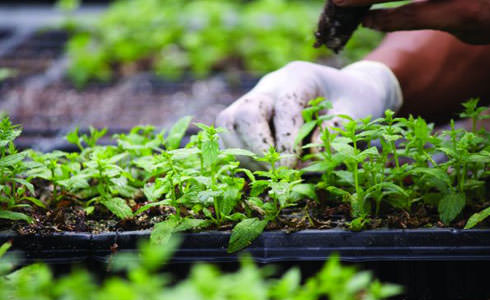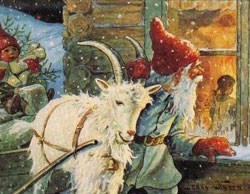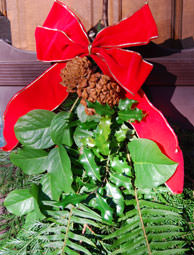
Courtesy Shenandoah Growers
Shenandoah Growers grows organic herbs in greenhouses so we can enjoy fresh herbs year-round.
Despite a mild few days, the handwriting is on the wall. It’s time to pull out, tidy up and harvest thoroughly for the last time. In the suburbs, our landscape is all soft greys and browns now.
Recipe: Chermoula
Ingredients
- 2 cups cilantro leaves (2 large bunches)
- 1½ cups parsley leaves (1 large bunch)
- 3 to 4 garlic cloves
- 1/2 to 3/4 tsp. salt, to taste
- 1 T. capers
- 1/2 tsp. hot pepper flakes, or 1/2 to 1 small, fresh hot pepper
- 2 anchovy filets, rinsed (optional
- 2 tsp. cumin seeds, lightly toasted and ground, or 1½ tsp. ground cumin
- 1 tsp. sweet paprika
- 1/2 tsp. coriander seeds, lightly toasted and ground, or 1/2 tsp. ground coriander
- 1/3 to 1/2 cup extra-virgin olive oil, to taste
- 1/4 cup freshly squeezed lemon juice
Preparation
Remove the stems of the cilantro and parsley. Place the herbs in a food processor along with the garlic and salt, and chop. Add remaining ingredients and more olive oil or salt if desired. Serve with grilled fish and vegetables, or with chicken.
Makes approximately 1 cup. Can be frozen in 1/4 cup foil packets.
From my herb garden, I had sage and parsley for the Thanksgiving turkey stuffing and some rosemary (already moved into a sunny window) for the carrots, but of course, the basil has already been frosted. However, all year-round, Shenandoah Growers in Harrisonburg, Va., sends both organic living herb plants and organic fresh-cut, packaged herbs to the East Coast, Florida and Ohio markets. What began as an entrepreneurial small business now features 80,000 square feet of state-of-the-art, closed-system greenhouses and 125 local employees and seasonal, small-scale growers. Pipes below the plants carry warm water through the rows; computer-controlled vents in the vaulted glass ceilings ventilate; and giant curtains protect the young plants from too much or too little sunlight.
Marketing Manager Sarah Yoder tells me that basil is, by far, the most popular herb plant, followed by cilantro and mint. “You just snip the amount you want. The oils remain much more concentrated because the leaves aren’t being handled,” she explains. The growing plants last much longer than the cut bunches, as well. Six other popular herbs are available as plants through Shenandoah Growers.
“People often don’t really know what to do with herbs, so we include growing and cooking tips with the plants,” adds Yoder. Shenandoah Growers’ website offers many more tips and tempting recipes. The cut herbs come in a wide line of one-recipe amounts—from the 1/4-ounce size up to larger 4-ounce catering packs—and a line of Latin flavors, too. All the herbs are sold in recyclable packaging.
Using these smaller amounts, you can experiment with fresh-cut herbs to see what you like, and then plan on growing them yourself next spring. You’ll also develop cooking routines that let you make better use of the bunches you buy.
Here are three ways (plus a fourth afterthought) to use up the extra from a large bunch of herbs or to hold on to what’s still growing for you this year.
Herb Salt
Use aromatic and sturdy herbs like rosemary or thyme. Make sure the herbs aren’t at all damp, dice them and combine them with kosher salt—about 2 T. herbs to 1/2 cup salt. Wait a couple of weeks for the herb flavors to infuse the salt.
Pesto
An obvious use, but try a new combo. Chermoula is a parsley-cilantro pesto with capers, garlic and anchovies and no cheese (see recipe above). Or try mixed herbs whirred with roasted red peppers. Add almonds instead of pine nuts. Walnuts, cream, thyme, lemon? Leave out any cheese when you freeze your favorite, and add it in when defrosted. Of course, salsas and chimichurri use fresh herbs up nicely, too, but they don’t freeze very well.
Flavored Vinegar
What could be simpler? Half cider vinegar, half white wine in a pretty bottle; add sprigs of rosemary, tarragon, sage and mint together or use them solo; also try lemon or orange rind, garlic cloves, and black or red peppercorns. Let the bottles sit awhile to mellow. Use up dribs and drabs of unfinished red wine, too, but the clarity of the white combination is nicer for gifts.
Herb Afterthought …
While writing this post, I thought of another great herb use: If you chop up the herbs finely and mix them with dry mustard powder and the same white wine (or beer or fruit juice) into a smooth paste, you ‘ll make a dynamite gourmet herb mustard. Homemade herb mustard is burning hot to start so mix it up a few weeks before you use or gift it away.
Read more of The Hungry Locavore »















